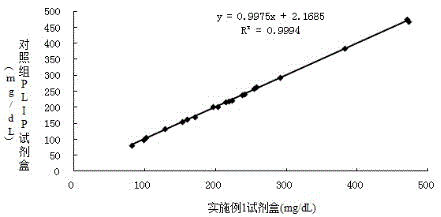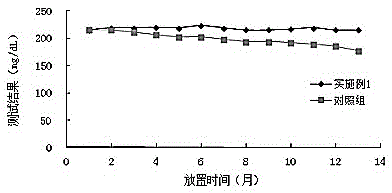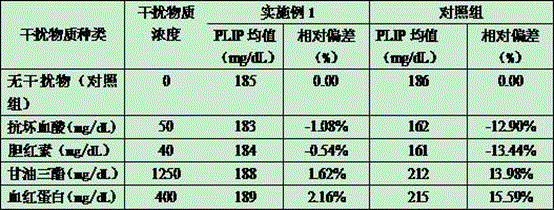A stable serum phospholipid detecting reagent high in interference-resisting capability and a detecting method
A technology for serum phospholipids and detection reagents, which is applied in biochemical equipment and methods, microbiological determination/inspection, etc. It can solve the problems of reagents that are harmful to operators, difficult to realize automatic operation, poor stability of reagents, etc., and achieve enhanced anti-interference Ability, improve anti-interference ability, improve the effect of stability
- Summary
- Abstract
- Description
- Claims
- Application Information
AI Technical Summary
Problems solved by technology
Method used
Image
Examples
Embodiment 1
[0060] Serum phospholipid detection reagents, including reagent R1 and reagent R2:
[0061] 1) The composition of its R1 is:
[0062] HEPES (4-hydroxyethylpiperazineethanesulfonic acid) buffer solution (pH=7.2, 25°C) · 100mmol / L,
[0063] Phospholipase D ······································· 1KU / L,
[0064] DAOS ·········································· 1.4mmol / L,
[0065] ascorbate oxidase ································ 2KU / L,
[0066] Bilirubin oxidase ·································· 2KU / L,
[0067] polyethylene glycol 6000 ·································· 10g / L,
[0068] sucrose ·········································· 20g / L,
[0069] xanthan gum ········································ 0.5g / L,
[0070] Mannitol ········································ 20g / L,
[0071] Trehalose ········································ 10g / L,
[0072] BSA ··········································· 2g / L,
Embodiment 2
[0094] Interference test: take fresh mixed serum, divide it into 2 equal parts, then divide each equal part into 5 equal parts, add different interfering substances, so that the concentration in the serum reaches the requirements in Table 2. Then, the reagents obtained in Example 1 were used to compare and measure the content of PLIP in serum at the same time as the common and recognized serum phospholipid (PLIP) reagent in the market. Relative deviation (%) = (measuring mean value of interference samples - measuring mean value of control samples) / measured mean value of control samples × 100%.
[0095] It can be seen from Table 2 that the reagent of Example 1 has no obvious interference on the test results when ascorbic acid≤50mg / dL, bilirubin≤40mg / dL, triglyceride≤1250mg / dL, and hemoglobin≤400mg / dL. However, the reagents of the control group were significantly disturbed when the above-mentioned concentration of interfering substances existed, which indicated that by optimizin...
Embodiment 3
[0099] Correlation experiment: using the formula in Example 1 to prepare reagents, and conducting a control test with a phospholipid kit from a company approved by the State Food and Drug Administration, which is common in the market, and testing 20 clinical serum samples at the same time, the test results are shown in Table 3 . And obtained the correlation curve of the two reagents (such as figure 1 Shown), the test results show that the correlation coefficient of the two kits is 0.9997, indicating that there is a great correlation between the two.
[0100] Table 3 Example 1 reagents and market common and recognized serum phospholipid assay kit comparative detection results
[0101]
PUM
 Login to View More
Login to View More Abstract
Description
Claims
Application Information
 Login to View More
Login to View More - R&D
- Intellectual Property
- Life Sciences
- Materials
- Tech Scout
- Unparalleled Data Quality
- Higher Quality Content
- 60% Fewer Hallucinations
Browse by: Latest US Patents, China's latest patents, Technical Efficacy Thesaurus, Application Domain, Technology Topic, Popular Technical Reports.
© 2025 PatSnap. All rights reserved.Legal|Privacy policy|Modern Slavery Act Transparency Statement|Sitemap|About US| Contact US: help@patsnap.com



